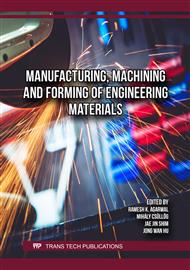[1]
Balajti, Zs.: Constructive Geometric Method for the Analysis of the Manufacturing Accuracy of Helicoid Drives, Invited Plenari Lecture in the 8th International Scientific Conference on Geometry and Graphics, moNGeometrija 2021, Edition of Serbian Society of Geometry and Graphics (SUGIG), 2021., 273 p. pp.9-18. , 10 p.
Google Scholar
[2]
Balajti, Zs.: New Modelling of Computer Aided Design of Worms in the Same Axis, MANUFACTURING AND INDUSTRIAL ENGINEERING, 2012, 11, 2, 26-29. https://real.mtak.hu/46117/
Google Scholar
[3]
Bodzás S.: Kúpos csiga-, tányérkerék- és szerszám felületek kapcsolódásának elemzése, Ph.D. értekezés, Miskolci Egyetem, 2014., p.154., Doktori témavezető: Prof. Dr. Dudás Illés
Google Scholar
[4]
Bohle, F.: Spiroid Gears and Their Characteristics Machinery, 06. 01. 1956.
Google Scholar
[5]
Dudás I., Bodzás S., Dudás I. Sz., Mándy Z.: Konkáv menetprofilú spiroid csigahajtópár és eljárás annak köszörüléssel történő előállítására, Szabadalmi iktatószám: P1200405, Szabadalmi bejelentés napja: 2012.07.04.
Google Scholar
[6]
Dudás, I., Balajti, Zs., Bányai, K.: Accurate Production of Helicoid Surfaces, III. International Congress of Precision Machining Vienna-Austria (ICPM 2005), 18-19. October 2005, 27-32.
Google Scholar
[7]
Dudás, I., Balajti, Zs.: Analysis of Characteristic Curve in Case of the Wearing of the Grinding Wheel, In proceeding of microCAD 2009 International Scientific Conference, Section M: Production Engineering and Manufacturing Systems, Miskolc, Hungary, 19-20 March 2009, 269-276, ISBN 978-963-661-866-7 Ö, 978-963-661-877-0
Google Scholar
[8]
Dudás, I., Leirath, F., Balajti, Zs.: Analysis of the Production Process of the Arched Worm Profile, In proceeding of 12th International Conference on Tools, Miskolc, Hungary, 6-8. September 2007. 169-174.
Google Scholar
[9]
Dudás, I.: The Theory and Practice of Worm Gear Drives Penton Press, London, p.314, 2000., ISBN 1877180295
Google Scholar
[10]
Dudás, I.; Bodzás, S.; Dudás, I. Sz.; Mándy, Z.: Development of spiroid worm gear drive having arched profile in axial section and a new technology of spiroid worm manufacturing with lathe center displacement, International Journal of Advanced Manufacturing Technology 79: 9-12 pp.1881-1892., 12 p., 2015., https://link.springer.com/article/
DOI: 10.1007/s00170-015-6953-1
Google Scholar
[11]
Hegyháti, J.: Untersuchungen zur Anwendung von Spiroidgetrieben. Dissertation, TU Dresden, 1988.
Google Scholar
[12]
Mándy, Z.: Csavarfelületek előállításának intelligens gyártórendszere és geometriailag helyes megmunkálása, Miskolc, Ph.D dissertation, University of Miskolc, 2022.
Google Scholar
[13]
Radzevich S. P.: Dudley's Handbook of Practical Gear Design and Manufacture, Third edition, CRC Press, p.656, 2016., ISBN 9781498753104
Google Scholar
[14]
Litvin, F. L., Fuentes, A.: Gear Geometry and Applied Theory, Cambridge University Press, 2004., ISBN 978 0 521 81517 8
Google Scholar



